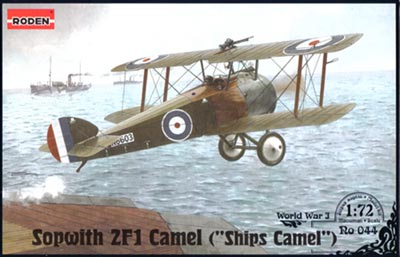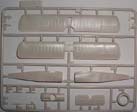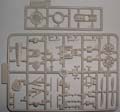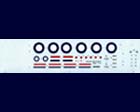| Roden 1/72 Sopwith 2F.1 Camel Review |
| |
 |
|
| The Roden 2F.1 Camel has been out for over a month now and
there's still no sign of them here in the UK, which is rather ironic since
it's a British aircraft. Being the impatient fellow I am I gave up waiting
for them and ordered mine from Hobbyterra.
They took about the same amount of time that a certain large UK mail order
establishment takes and their prices on Roden stuff are less than half.
Will I be ordering all my Roden stuff from them in future? Was the Pope
a member of the Hitler Youth Group? |
| So, on to the eagerly anticipated (by me anyway) Camel kit.
Well, I'm somewhat disappointed to report that it's a bit of a mixed bag
unfortunately. On the plus side, the moulding is up to Roden's usual excellent
standard, the engines, props, wheels and guns are excellent and the struts
are nice and fine. There is a nice little Rotherham pump moulded to one
of the cabane struts. The fuselage is quite well done and cockpit detail
is nice and fairly complete, though the control stick is far too short -
about the right size for Sneezy or Grumpy if they had been Camel pilots.
I like the separate rear deck which will mean there will be no loss of stringer
detail as there would be when filling a central seam. There is an extra
throttle and rudder bar which I'm assuming will be used on the forthcoming
2 seat version. |
| You get loads of extra parts as is usual with a Roden kit.
There are three engines (Le Rhone, Bentley and a Clerget), 2 propellers,
2 cowlings, 2 cockpit deckings, 2 Vickers and 1 Lewis gun with spare ammo
drums, and a set of Cooper bombs. A windscreen is printed on clear acetate
though this isn't necessarily correct for all aircraft. |
| Decals look quite nice and include markings for 4 aircraft:
N6603, the fourth production 2F.1; the well known N6602 with its unique
lattice fuselage markings; N7149 "Swillington" and N7120 from
HMS Queen Elizabeth. 'Lift here' stencils and elevator/rudder stripes are
included. The red centre dots are seperate though the white on my sheet
was out of register and the blue may be a bit dark for some people's tastes. |
|
|
| On the downside, though the general dimensions are correct,
compared to photographs and plans there are some fairly major outline errors.
The wings need to have the tips re-shaped, the trailing edge cut out above
the cockpit is too big and the divisions between the outer panels and the
centre section need to be scribed in. The pulley inspection panels are moulded
in but the one in the centre section is on the left when it should be on
the right. Removing it will mean there is a blank spot where the l/e sub
ribs should be. |
| The horizontal stab is the worst feature. It is far too small
and the wrong shape entirely. Dig out your old Revell Camels because the
stab is spot on in that kit and the moulding quality is comparable to Roden's
so it can be used with little modification. |
| The fuselage of the 2F.1 was in two sections and could be
disassembled for storage aboard ship - it was often referred to as the "Ship's
Camel" or "Split Camel" for this reason. The break just behind
the cockpit is scribed in on one side but a raised line on the other; perhaps
Roden thought this was a hinge covered by a strip of fabric? The lacing
on the right side of the fuselage is represented by a relatively thick featureless
raised line and the vertical part of this behind the cockpit is missing
entirely. Also the rear fuselage has a subtle sag moulded in between the
uprights. The jury's still out on this. It is subtle but I can't see a hint
of any sag in photos; the fuselage is pretty much flat sided, even in flight.
There is a fairing behind the carburettor intake that only seems to have
been on a very few F.1 Camels and is not a feature of the 2F.1 at all, at
least not that I could see. It certainly wasn't on any of the aircraft featured
on the decal sheet so this will have to be removed if you wish to model
one of them. |
| The cowling for the Bentley has the right shape (larger diameter
that tapers into the fuselage as opposed to the straight regular cowling)
but Roden has moulded cooling slots into it that I have yet to find a photo
of on any version of the Camel. These will be very annoying to fill in.
I can't find a good enough picture to determine what engine N7120 had but
the other 3 were Bentley powered aircraft with the larger upper decking
and cowling (parts 1K, 2K & 3K). Roden's instructions say to use the
Clerget engine & small cowl for N6602 but I believe this to be incorrect
as this should be Bentley powered. |
| All in all, a bit of a disappointment to be honest and not
up to the high standards of other Roden kits. It will need a fair amount
of work to look right and in some respects it's not as good as the 40 year
old Revell kit. The major airframe components are on a single sprue so these
will (I hope!) be all new parts for the F.1 - let's hope that they do a
better job on that one. |
References:
- Windsock Datafile 6. J M Bruce, Albatros Productions, 1987, 1996
- Sopwith Camel, King of Combat. Chaz Bowyer, Glasney Press 1978
- Sopwith Camel. J M Bruce, Arms & Armour Press, 1989
|
| |




